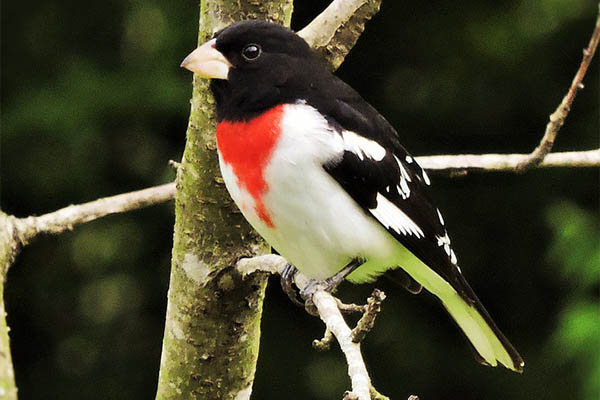Contents
- Rose-breasted grosbeak facts
- Rose-breasted grosbeak: how-to identify
- Rose-breasted grosbeak bird vocalization
- Where You’ll See Rose-Breasted Grosbeaks
- Rose-breasted grosbeak diet
- Rose-breasted grosbeak nesting
- Rose-breasted grosbeak behavior
- How-to attract rose-breasted grosbeaks
- Rose-breasted grosbeak threats
- Rose-breasted grosbeak fun & interesting facts
- Rose-breasted grosbeak related species in this family
The Rose-breasted Grosbeak is a beautiful bird known for its black and white pattern with a rosy-red chest. These birds would come and go, so make sure that you don’t miss them when they start arriving. They have very distinct voices that are described to be similar to American Robins, but only with added sweetness.
In this article, we are going to cover a wide variety of topics related to the Rose-breasted Grosbeak, such as:
- How to identify them
- How, when, and where they migrate
- Their diet
- How and where they nest
- And much more…
So, without any more delay…
Let’s jump right into it and learn more about the Rose-breasted Grosbeak.
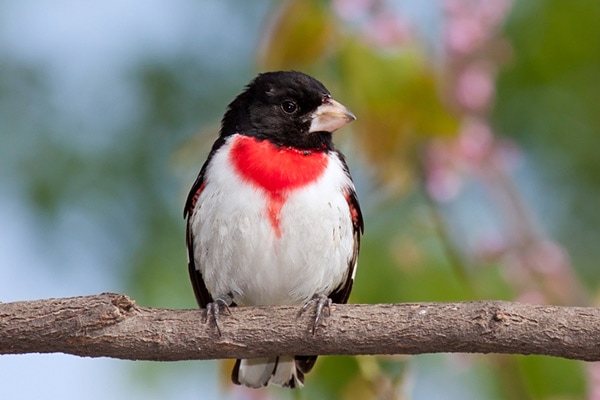
Rose-breasted grosbeak facts
- Common Name: Rose-breasted Grosbeak
- Scientific Name: Pheucticus ludovicianus
- Scientific Family: Cardinalidae
- Life Span: 12.11 years
- Size: 7.1 to 8.3 inches
- Wingspan: 11.4 to 13.0 inches
- Weight: 1.4 to 1.7 oz
- Conservation status: Least Concern (LC)
Rose-breasted grosbeak: how-to identify
Rose-breasted Grosbeaks are medium-sized birds that are about 7.25 inches in length. They have stocky bodies with huge, conical, pale bills. They also have a broad chest, a short neck, and a medium-length, squared tail.
Differences Between Male & Female
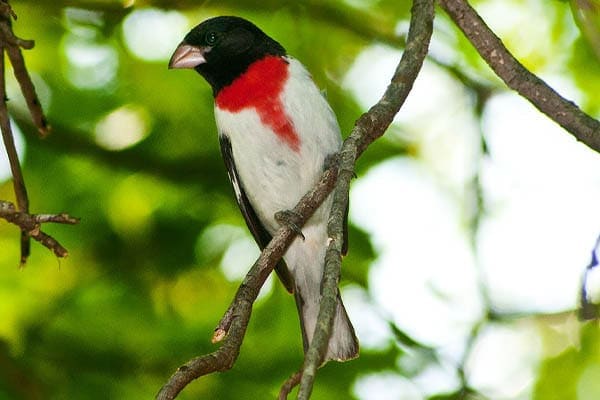
Male and female Rose-breasted Grosbeaks don’t look similar to each other. And like many birds, the “rose-breasted” part in their names mainly refers to the males.
Male birds are easily recognizable with their black head and upperparts and white underparts. On their chest, you’ll notice a triangular-shaped rose-red patch where they got their name. Their black wings come with white patches, and you’ll also see some white spots on their tail. Added to that, they have rose-red wing linings.
Female birds, on the other hand, are mainly brown in color. Their upperparts are generally darker than their underparts, and you’ll also notice that they are heavily streaked. Females also have a noticeable white eyebrow and yellow to yellow-orange wing linings.
Differences In Summer Plumage vs Winter Plumage
Male Rose-breasted Grosbeaks molts before migrating in winter. Because of this, you’ll notice a significant difference in their plumages between summer and winter.
During winter, the male birds appear paler and browner, almost resembling the female birds. Their upperparts are generally darker than their underparts, and they are also heavily streaked. You’ll also notice yellow wing linings and a white eyebrow.
Females, on the other hand, don’t show any significant difference between their summer and winter plumage.
Rose-breasted grosbeak bird vocalization
Where You’ll See Rose-Breasted Grosbeaks
When you look at the map that shows how the bird’s population is distributed, the first thing you’ll notice is that Rose-breasted Grosbeaks are widespread across North America, but they mostly occupy the eastern areas.
They breed in northern areas of North America, with their range spreading from British Columbia to the northeastern part of the US, reaching Maine and the southern regions of Quebec and Nova Scotia.
During winter, the birds would fly down south and travel across Central America, with populations reaching coastal parts of Mexico, Guatemala, and Panama.
These birds often live in various wooded habitats such as swamps, moist deciduous forests, mixed woodlands, semi-open habitats, and forest edges. They tend to avoid dry woodlands and grasslands but are frequent visitors of parks, gardens, suburban areas, and orchards.
Rose-breasted grosbeak bird migration
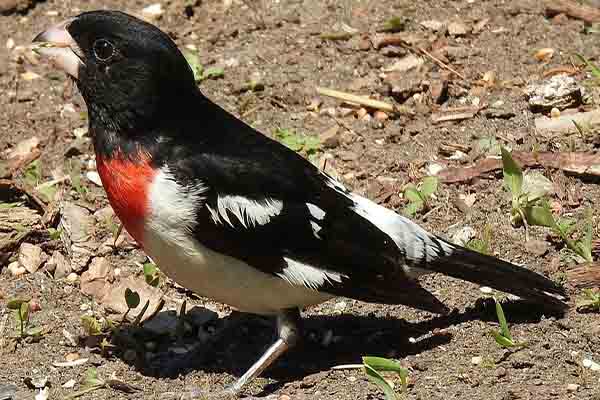
Rose-breasted Grosbeaks are known as long-distance migratory birds. These birds fly from their northern breeding grounds to their southern breeding grounds yearly, sometimes flying across the Gulf of Mexico in just one night.
These birds would leave their wintering grounds around mid-March to mid-April and would start arriving in their breeding grounds from late March to early May. Around fall, they will migrate again back to their wintering grounds around early September.
The birds often travel in flocks and would usually migrate at night.
Rose-breasted grosbeak diet
Rose-breasted Grosbeaks eat a variety of foods, and the quantity usually depends on the season.
Like many other birds, these birds would feed mainly on insects during the breeding season. This includes beetles, caterpillars, bugs, spiders, and even snails. The birds also eat fruits, berries, and sometimes ovaries of flowers.
During winter, the birds depend mainly on plant material and occasionally on some insects if they find any.
These birds usually search for food in shrubs and trees, hovering and snagging some insects on the barks. Sometimes, the birds also fly out and catch insects midair.
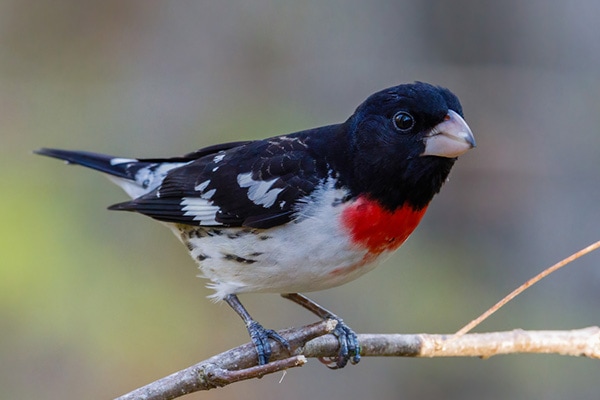
Rose-breasted grosbeak nesting
- Clutch Size: 1-5 eggs
- # of Broods: 1-2 broods
- Incubation Period: 11-14 days
- Nestling Period: 9-12 days
- Egg Description: Pale green to blue, with reddish brown or purplish speckles
A pair of Rose-breasted Grosbeaks are usually formed in Spring. Once it’s formed, the couple would choose a nest together, usually in a vertical fork of a deciduous tree or a large shrub. Nest height is usually 5 to 20 feet above the ground.
Unlike most birds, the male and female birds help each other to build the nest. It usually takes them 4-9 days to create a loose, open cup nest made of twigs, grasses, weeds, leaves, or straw. They will then line this with softer materials like rootlets or hair.
Rose-breasted grosbeak behavior
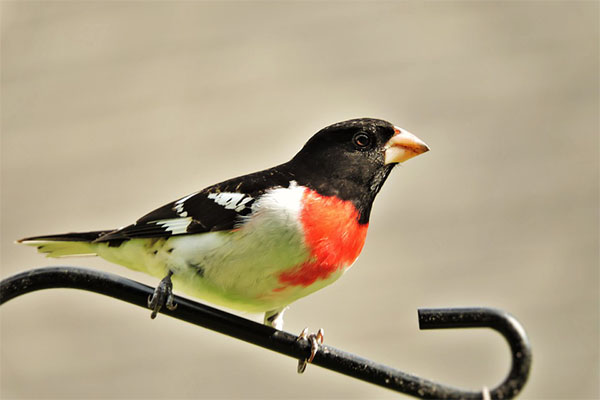
Rose-breasted Grosbeaks are migratory birds and would not stay in the same area for the whole year. They have a specific migration pattern that they already follow yearly.
Male Rose-breasted Grosbeaks would sing to establish territories and also to attract females. And once a pair is formed, the birds are observed to be monogamous.
Male birds are not highly aggressive and can tolerate males in their territories if they are silent. However, once startled, they would aggressively ward them off. Females, on the other hand, are also observed to ward off any female that tries to approach their mate.
How-to attract rose-breasted grosbeaks
Because Rose-breasted grosbeaks have a consistent migration pattern, it’s already easier for you to anticipate when they would be arriving. So, make sure that your backyard is prepared for their arrival.
Start by hanging some bird feeder filled with a mix of their favorite food such as sunflower and safflower seeds. Make sure to use a hopper, tray, tube feeders, or any feeders that have a perch where they can land.
If the birds visit you in the breeding season, then prepare some shelter or nesting sites for them. You can plant some trees and shrubs around you that they would love. Added to that, make your place insect-friendly.
Lastly, don’t forget to provide them water for drinking or bathing.
Rose-breasted grosbeak threats
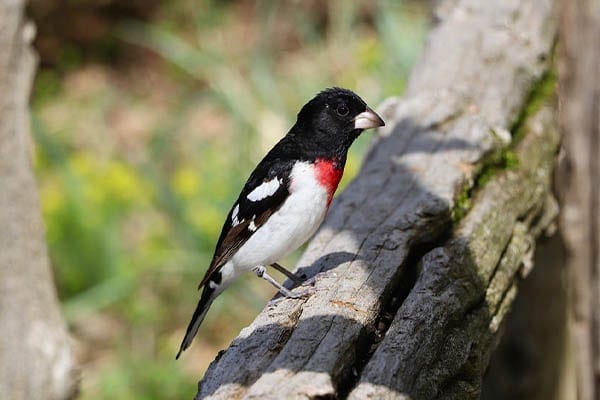
Rose-breasted Grosbeaks are common across their range and remain in the “least concern” group despite experiencing a slow decline in some areas. As these birds are migratory, collisions from buildings and towers are most likely the cause. They are also hunted by predators such as blue jays, common grackles, squirrels, and hawks.
Rose-breasted grosbeak fun & interesting facts
- Rose-breasted Grosbeaks were described as “so entrancingly beautiful that words cannot describe it” by several early 20th century naturalists.
- These birds are known for singing quietly on moonlit nights.
- These birds build a very thin nest that the eggs are seen through the bottom of the nest.
- Male and female Rose-breasted Grosbeaks take turns incubating their eggs.
- Two males share the record as the oldest recorded Rose-breasted Grosbeak.
- The oldest recorded Rose-breasted Grosbeak is 12 years and 11 months old.
- Hepatic Tanager
- Summer Tanager
- Scarlet Tanager
- Western Tanager
- Northern Cardinal
- Pyrrhuloxia
- Black-headed Grosbeak
- Blue Grosbeak
- Lazuli Bunting
- Indigo Bunting
- Varied Bunting
- Painted Bunting
- Dickcissel

